
July 30, 2016
 CR Sunday Interview Classic: Richard Thompson (2008)
CR Sunday Interview Classic: Richard Thompson (2008)


*****
I interviewed Richard Thompson for the first time on January 20, 2008. What follows is the result starting with the introduction. Thompson passed away on July 27. -- Tom Spurgeon
According to the original plan, an interview with the cartoonist
Richard Thompson was going to be one of the jewels of the 2007-2008 CR Holiday Interview Series, and I'm relieved that the piece wasn't lost to the confusion that followed this site's temporary outage. Thompson is one of the great, under-appreciated gems of modern American cartooning. His
Cul De Sac, which went into national syndication earlier this year, immediately became one of the five best features in any newspaper, period.
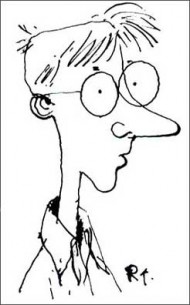
Featuring a wryly observed type of humor that comes from exploring kids' view of suburban life against a backdrop of slightly fragile family dynamics,
Cul De Sac has the advantages that strips frequently boast when they come from a previous dry run (
a Sundays-only edition for the Washington Post's magazine) and established talent: the designs are funny and idiosyncratic, the artist is comfortable presenting strips from multiple viewpoints, strips are driven by or at least reflected in the gestures and expressions of the drawn figures. In other words, the work comes out of the starting gate firing on all cylinders, as fully realized as some features a decade into their run. Thompson is also one of North America's accomplished caricaturists, and his piercing and funny
Richard's Poor Almanac in the
Washington Post is one of the few great remaining regional cartoon offerings, maybe the only one. I hope you'll explore his work.
*****
TOM SPURGEON: Richard, can I get a sense of what you have on your plate in terms of all your projects? With the daily being added to the weekly Cul De Sac
, I'm guessing that maybe you're not doing as much magazine work, but I could be totally mistaken about that. How have you geared up to take on the burden of a daily, and how has that worked so far?
RICHARD THOMPSON: I try to do as much magazine illustration work as I've always done, but fewer jobs that call for a quick turn around, like say the deadline is tomorrow and the sketch is due right now. I've done a lot of that over the years, sometimes to my regret, but sometimes the sudden death deadline stuff has turned out to be my best work. One thing that
Lee Salem at
Universal Press told me several times as I was gearing up to do a daily strip was "Keep your day job." My schedule is, every week I do a cartoon called
Richard's Poor Almanac (or
Almanack) for the
Post Saturday Style section, every other week I do a spot illustration for the
Post Health section, every month I do an illustration for
Smithsonian Magazine, and every day I have a
Cul de Sac which I usually send off in a week's worth of strips. And the freelance stuff fills any available space in between, as that and the Almanac are my "day job."
I was leery for years of the inevitable grind of a daily strip. Back in the early 1980s I heard
Doug Marlette speak at the Smithsonian, and someone asked him about that, the grind of a daily strip. He answered that he looked at it like brushing his teeth, he had to do that every day too, drawing his strip was just another part of his daily routine. I went home and looked at my toothbrush with sudden loathing. But now that I'm in the throes of a daily strip it's not quite as horrifying as I might've feared. Physically it can be hard, the drawing board forever looming overhead and the miles of white Bristol board to be covered, but mentally it's just about tolerable. It's early yet, so I haven't hit a fallow spot where the ideas are puny and scarce. Still though, I'm not very far ahead on the daily strip.
SPURGEON: In a related question, can you provide a general sketch of your work day and work week, how you compartmentalize?
THOMPSON: I'm terrible at compartmentalizing, which may be a good thing as ideas leak from one project to the next until they find their right home. Or at best, they recombine into something more interesting. Since I work at home there are also endless opportunities for distraction; oh, my daughters just got back from school, let's see how their day went. Here comes the mailman! Hey, it's snack time. Look, the cats are doing something funny! What's it like if I step outside?
Without an impending deadline I'm hopeless, nothing ever gets finished. Even with a deadline I'll fret over a drawing, or tear it up and start all over again so that work expands to fill the time available. This seems common among my friends in the business; either it's universal or us procrastinating drawing -- fretters all stick together. But briefly, my week is: the
Almanac is due on Friday so I try to do
Cul stuff early in the week and other freelance chores as I need to. I try to have a vague notion of the
Almanac by Wednesday, although that sometimes stays vague right up till early Friday morning. And then things spill over into the weekend because that's two whole extra days, like bonus work days where no one'll call asking if I've finished that sketch yet. I've always liked working late at night, I think my family is genetically nocturnal, and that can too easily turn into an all-nighter. But I'm trying to get away from that.
 SPURGEON: You provided Alan Gardner with a pretty exquisite list of favorite cartoonists, but I was wondering if you could speak to where other cartoonists have been a direct influence on aspects of your work. I can see the Pat Oliphant influence on aspects of your work, and MAD Magazine in the way you construct your set pieces, for example. Where do you feel your work is most strongly influenced by a past cartoonist?
SPURGEON: You provided Alan Gardner with a pretty exquisite list of favorite cartoonists, but I was wondering if you could speak to where other cartoonists have been a direct influence on aspects of your work. I can see the Pat Oliphant influence on aspects of your work, and MAD Magazine in the way you construct your set pieces, for example. Where do you feel your work is most strongly influenced by a past cartoonist?
THOMPSON: That list might've been a little pretentious for a guy who draws a strip featuring a talking guinea pig. The list had the complete staff of
Mad Magazine and
Honore Daumier cheek by jowl, but I could add another dozen names to it with ease (I'm kicking myself for leaving off
Quentin Blake).
I don't think I can point to one area where I'm most influenced by any one cartoonist, there are so many whose work has turned my head over the years, sometimes a new one every day. I taught illustration a little bit at the Maryland Institute of Art in Baltimore, just as an adjunct professor. It was fun but I ran out of things to say pretty fast. The students would always ask about influences and style, how do you develop a style, and all I could think was, you steal parts from everyone whose work you love and stitch them into this Frankenstein monster and over the years the scars heal and,
voila, a "style." But drawing style's pretty much a surface thing and may be a function of physiological things, like how your hand & arm move and the speed with which you draw. I think my best work is done when my hand is moving just a second or two ahead of my brain.
Since I'm doing the strip now, I keep thinking in terms of six days, the dailies, and how they link up, and I keep thinking about
Pogo, since that's been my favorite since fifth grade. What I always loved about it was the continual flow of incident, one character would start off on an errand, then another would intervene and another and it'd fly off on a tangent, then they'd get hung up in Miz Beaver's wash on the line, then they'd take a nap and suddenly those little idiot bats with the derbies would blow across the panel and it was like an endless pageant of comic surprises. That's what I'd love to do with
Cul de Sac, though it takes time to develop that skill and to command the readers' attention to make it work. New strips have to assume that each day the reader has to be reintroduced to it, to its characters and situations. Until we've beaten some sense into the readership.
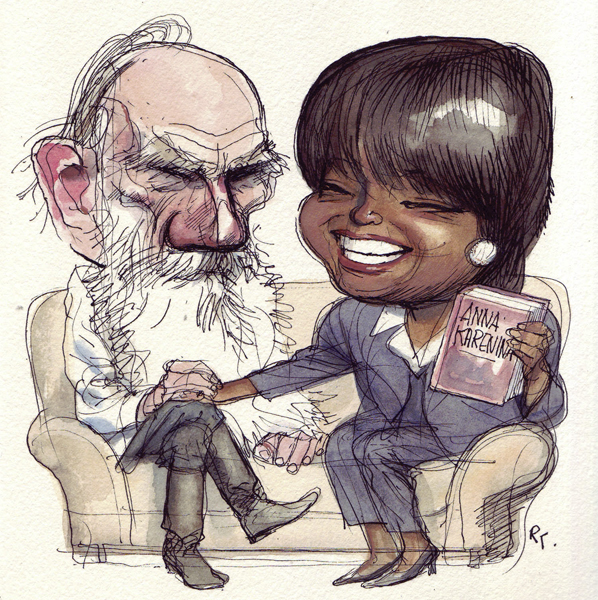 SPURGEON: You worked for years in caricature. Are your influences the same in that field, or is there a different set of artists that helped inform you work there, say Hermann Mejia or David Levine?
SPURGEON: You worked for years in caricature. Are your influences the same in that field, or is there a different set of artists that helped inform you work there, say Hermann Mejia or David Levine?
THOMPSON: Some are the same, like
Ed Sorel, who I think of as a cartoonist as much as caricaturist & illustrator. There are many caricaturists whose work I love but I wouldn't call influences. David Levine scared me off crosshatching, because no one paints with lines like he does.
Al Hirschfeld is another; I love his work but I couldn't learn anything from it, he's perfected that approach. Daumier is still the greatest caricaturist, I think because he worked from memory of life; he'd go watch these French politicians then go home and mold them in clay, like he held their forms in his mind until he could get them down in some medium. The few caricatures I've done that I really love have all been from memory, memory of photographs in my case, but where I feel like I understand how their faces work. Nothing comes out more poorly than a caricature drawn from a single photograph, especially if it's a well-lit, airbrushed official portrait photo that blands out the features.
But Sorel's probably my favorite. I love how he boils the subject down to lines that fly across the paper, how he carves it right into the page. and how he constructs whole environments for the subject, you know, figures in a landscape or interior. Especially the historic subjects where he can go nuts with costumes and such. And the obvious joy he gets from doing a subject he loves, like the movies or literature. I did a political caricature every week for nine years for
US News & World Report on a real short deadline and Sorel was who I'd turn to when things looked grim and I'd forgotten how to draw. Plus he draws the greatest hands.
SPURGEON: Some artists feel that caricature is a completely different form than cartooning in terms where the reductions and exaggerations are, how do you feel about those distinctions, and if it does, how does your skill with caricature continue to inform your cartooning work?
THOMPSON: It probably is different, I hadn't thought about it much, but some talent for caricature opens up whole new worlds of possible subject matter. Like you can do politics without luggage tags that say "Cheney" or "Hillary." Though, as they say, a political caricature doesn't necessarily make it a political cartoon.
For the Almanac it opens up all kinds of possibilities, drawing politicians, actors, writers or whoever. Like it's fun to draw an Oscar Award cartoon and show hard-working Hollywood homunculus Tom Cruise getting trapped in the folding seat or falling into the fancy gift bag they give to all the VIPs, only to be discovered hours later. Whenever you get a chance to draw a teeny-weeny Tom Cruise stuck in a folding chair, grab it.
For
Cul de Sac, at least in its earlier form in the
Post Magazine, it was fun to cast passing characters from faces I'd seen here and there. A delivery man for FedUps and a deli counterman were both taken from people in my neighborhood, more or less.
SPURGEON: I'm unfamiliar with how Richard's Poor Almanac
began in the Post
. Given that it's such a unique feature, can you describe how it kind of won its place on the Post
's pages, and the parameters of your working relationship with the paper over the time it's run?
THOMPSON: It was one thing leading to another despite me dragging my heels. For about five years in the early 90s I illustrated a column in the
Post's Style section by
Joel Achenbach called
Why Things Are. He'd answer any odd or interesting question thrown at him by readers from the ridiculous to the sublime and the editor gave me free reign to do whatever I wanted as long as it was at least tangentially about the given subject. So I ended up doing the illustrations as free-standing cartoons, with dialog in balloons and as many gags as I could cram in. It was a small but very satisfying weekly job and it paid a little better than some newspaper illustration work because the Post Writer's Group syndicated it.
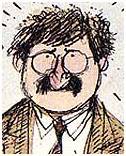
The editor who hired me for
Why Things Are was
Gene Weingarten, who's now the
Post Magazine's humor columnist and who came to the
Post from the
Miami Herald where, among many other things, he'd given
Dave Barry his start.
Why Things Are came to and end around '95, and Gene called me sometime after and said, why don't you try doing a weekly cartoon? He's a dream editor to work with, you just want to make him laugh good and hard. especially at something inappropriate. We had lunch and then, a year later, I gave him a couple dozen roughs and he said, ok, it took you long enough, let's go. It started in June of '97 without an actual title or any apparent purpose other than to try and be funny. The early ones were all over the map and kinda hit or miss. At that point I'd only done a few stand alone pieces with only my name on them and I was a little nervous about it, but the Post seemed game for the whatever I was coming up with. One early one was called The Madness of Mayor McCheese, and it just showed, in maybe six panels, Mayor McCheese staggering blindly across an empty landscape counting "39,547,634,943,;39,547,634,944" etc, etc while rubbing his hands together like Lady Macbeth. Another was the quote "In the country of the blind the one-eyed man is king" illustrated by a drawing of a one-eyed king in a sedan chair borne by four blind footmen through a crowd of blind people and he's yelling, "Watch out! Go left! No, your other left! Ok, now right! NO! Dog! don't step on the dog!"
Who knows what this stuff was doing in a respected newspaper, but it cracked me up and Gene liked it, and nobody actively complained. I was always expecting it to be plowed under and replaced by tire ads or garden center coupons. I'd calm my nerves with the likelihood that no one was actually reading it, so why worry if the jokes made sense to anyone else?
Tom Shroder, my third editor who as the
Post Magazine editor pushed me into starting
Cul de Sac, finally gave it a title around 1999; I'd included a reference to "Richard's Poor Almanac" in one cartoon and he said, "Call it that."
I've been through six editors now over the last 10+ years and they've all been good people to deal with. Nowadays my editor, Ann Gerhart, doesn't ask for a rough, or even any idea of what I'm doing, so I guess we've reached a level of trust, or maybe nobody's reading it still. The only complaint I ever remember getting from Gene, whose motto is that he edits for humor but not for taste, was when I used the phrase "fart-catcher" to describe a presidential aide twice in as many weeks and he found that excessive. But like I said, nowadays we pretty much leave each other alone, except when I've spelled something wrong or when the grammar's iffy, and then I hear from Suzanne Tobin who copy edits all the comics.
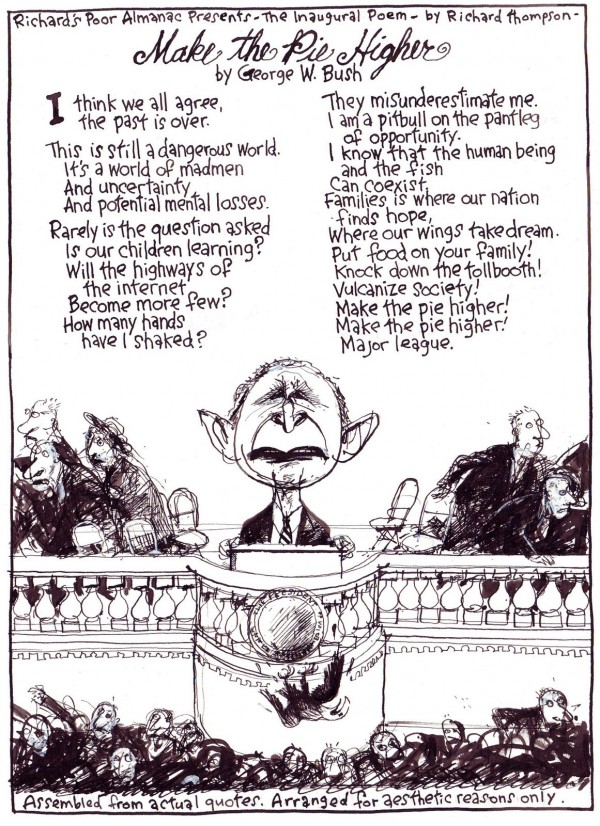 SPURGEON: Many of us first became aware of you because of Make the Pie Higher; what was it like having a cartoon kind of blow up at least within American political culture, and have so much attention paid to it?
SPURGEON: Many of us first became aware of you because of Make the Pie Higher; what was it like having a cartoon kind of blow up at least within American political culture, and have so much attention paid to it?
THOMPSON: I did Make the Pie Higher the week of Bush's first inaugural in response to his lack of a major poet reading an inspiring poem, like Carl Sandburg did for Kennedy or Maya Angelou did for Clinton. It seemed a big deal at the time, this lack of major poetry. So I took a bunch of Bushisms, you know, his malaprop comments, and formed them into a free-verse poem. When I sent the rough to Tom Shroder, who was then editing Sunday Style, he said are these real quotes? And I said yes, they all have sources, and he said OK great. When I put it together it seemed kind of a clever idea, though I wondered who would get it. But it ran, and I liked the drawing I did of Bush addressing the crowd. About six months later Tom called and said, "That Pie thing's all over the internet and it's even got your name on it (as a
Post writer)." But so much stuff gets all over the Internet it didn't register with me much until I started getting requests to set it to music, and a friend who plays in a folk group told me they'd been singing it for a year or two without knowing who wrote it. Well, assembled it. Now by my count it's been set to music eight or nine times, including Irish ballad style and for women's chorus. If I had any business acumen I'd've made some money off it. My favorite bit is that
it's got a page on Snopes.com that verifies all the Bush quotes, with only one that may be iffy, the one about being a "pitbull on the pants leg of opportunity."
SPURGEON: What to your mind makes a good subject or potentially good end result on an Almanac strip? Sometimes you pick obscure subjects, but you also trade in broader, more traditional folk humor subjects where the strength isn't so much the concept but your detail work, your take on the subject. Is that a fair observation, or do you see your approach as fairly singular? How much time do you spend developing ideas and do you have a process for doing so?
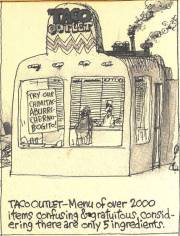 THOMPSON:
THOMPSON: I quickly found that Washington DC was the best subject, not as Capitol of the Free World, but as a place where people live and work and eat and drive and get fed up with tourists. And the
Post itself is fun to pick on, especially the odd little niches within it. I've done a string of cartoons about the weekly roundup of restaurants closed by the health department; restaurants are inherently funny places and buildings are fun to draw. Being an Almanac, natural phenomena like weather and night sky guides are good, and I've done traffic forecasts and Your Week in Dreams Previewed several times, and if nothing else comes to mind I do a caricature of somebody in the news with instructions on how to cut it out and make a finger puppet.
The most obscure one I ever did was probably a guide to pronouncing the name of the painter
Ingres, which I always have trouble with (it's "Annggh" I think). I drew it when the National Gallery had a big show of his work and it had six panels showing various tourists, each in front of various portraits by Ingres, mispronouncing his name, Injures, Angers, Egress, etc, and each portrait reacting with disgust. In the final panel the tourist says "Anal!" and the portrait bellows "Imbecile!" I turned it in and my editor said, "Is this guy real? Okay, good." And I figured the other three people in DC who knew who Ingres was but couldn't pronounce it would laugh at this cartoon 'cause, boy, they've been waiting for somebody to address this issue. Then about a month later I got a call from a curator at the Metropolitan Museum of Art, where the Ingres show was to travel next, saying how they'd been passing the cartoon around and it was a hoot, and could they put it on a t-shirt to sell in the Ingres-theme shop? I said sure, of course, though it was not much money but you know, the glamor was overwhelming. And they did, they sold t-shirts in the shop with a cartoon on it calling Ingres Egress and Anal and stuff, and there was a column in the
Wall Street Journal about it, how the Met was lowering itself by vending such trash, which was satisfying to me professionally of course. And the Met never sent back the original cartoon and I didn't complain because now I can say I'm in the collection of the Metropolitan Museum of Art in New York, if only inadvertently.
That wandered some distance from your question. Yeah, I do folk humor where the fun is in the nuts and bolts, and some political humor, usually more tangentially because I don't think clearly about politics, other than I know what I like. The hard thing about ideas is not getting them, but knowing what to do with them. The context & presentation of a joke are the important parts, I think; is it told or shown? Do you step back from it and frame it within something larger, take it apart and spoil it with a counter-joke or string it out into a theme with variations? Last month, in a holiday frame of mind, the word "tinselectomy" popped into my head and I thought, who gets a tinselectomy? Santa of course, he's old and fat and prone to such things, but then what? So it turned into an Almanac with a list of shopping mall Santas to avoid, the second one being the Santa at Paymore Plaza in Rockville, Maryland who won't shut up about his personal problems. He's pictured with a small, bored-looking child on his knee and he's whining about his allergies to elf dander and his recent emergency tinselectomy. So from meager beginnings a tiny shrub blossomed, nothing fancy but it fit into my Almanac space just dandy. And Santa's fun to draw.
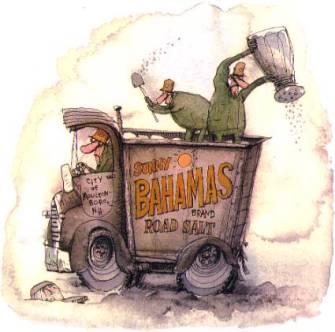 SPURGEON: Am I right in that
SPURGEON: Am I right in that Cul De Sac
grew out of an element of Richard's Poor Almanac
, a kind of strip you were doing there?
THOMPSON: Sort of, though not by plan. Tom Shroder, who was my third editor on the Almanac, took over as editor of the
Post Magazine about eight years ago, and I did weekly illustration work for him, drawing for Gene Weingarten's humor column. Tom asked me in about 2002 if I'd be interested in doing a weekly strip with continuing characters about Washington DC. I said let's talk about it and then, in Tom's words, "it took a year to schedule lunch. After that, we lost momentum."
But what we finally agreed on was, it should be about DC, but not about The Capitol of the Free World, just about some people who live around here. I picked the suburbs, as I know them well, but with some trepidation because who needs another comic set in the suburbs? And I put all these little kids in it. I'd done about six
Almanac cartoons called "Baby Roundtable" or "Toddler Roundtable" where I had small children arguing issues of the day, like the effectiveness of the
Mozart Effect or the use of drugs to control learning disorders or the superiority of children's literature to adult literature, and they were all real fun to do. All the little tangents the kids could fly off on, and how they ended up either crying or pushing each other's heads into the Play Doh. Actually the first Roundtable cartoon was back in the early '90s, as an illustration for the question "Why are babies cute?" for
Why Things Are.
So the more sketches I did for Tom the more the little kids took it over. Alice pretty quickly became an Irresistible Force and Petey became an Immovable Object and their suburb became in my mind a kinda surreal place that looked like a movie still I found of the city in
The Cabinet of Dr. Caligari, all piled up on its hill. So after about a year of dawdling I showed Tom the sketches and the title
Cul de Sac, which I worried was too bland until an editor told me it means "bottom of the bag" in French. And what's funnier than the bottom of the bag in French?
 SPURGEON: What was involved in the final decision that made you want to go with dailies and take the whole thing national?
SPURGEON: What was involved in the final decision that made you want to go with dailies and take the whole thing national?
THOMPSON: Another string of fortunate events. In December of '05 I got an email out of the blue from Lee Salem, then editor in chief now president of Universal Press. He's seen that Make the Pie Higher poem on the internet with my name on it as a
Post writer and wanted to know where it had appeared. He didn't know it was connected to a cartoon but was tickled to hear it, and he ordered the
Almanac book and saw the Oliphant forward, which gave it some gravitas. We kept in touch for a few months and he came to DC for a convention and we met for a drink.
I'd been thinking about the characters in
Cul de Sac and wondering what they did on weekdays, away from the Sunday strip. Each time I'd draw a Sunday there was all this unused material, some good some not, but I realized that it had the makings of a daily strip. And as you know, when you work on a comic strip you start hearing the little voices in you head and they must be obeyed. So I took a batch of the Sunday
Culs when I met with Lee. We had a nice chat, I gave him the copies, and he said let's keep in touch. We did, and in a long, gradual process I got a development deal, which involved turning in a month of daily roughs every month for about a year plus a visit to Universal Press in Kansas City and a some long dinners in nice restaurants. Which as a scrawny little guy I appreciated.
I might've eventually submitted
Cul to syndicates without the email out of the blue from Lee Salem, as I was becoming convinced I was capable of producing a daily. But the Higher Pie thing sure kickstarted things, so you could say that I found my job thanks to George W Bush's lack of inaugural poetry.
 SPURGEON: You launched with a strong 70 papers; how has it gone since then to now? Is there any way you'd be willing to characterize the nature of your current presence, what kind of papers, what you're hearing back?
SPURGEON: You launched with a strong 70 papers; how has it gone since then to now? Is there any way you'd be willing to characterize the nature of your current presence, what kind of papers, what you're hearing back?
THOMPSON: It's doing pretty well in a tough and shrinking market. I hear it's in about 100 papers, and just knowing there
are 100 papers is comforting these days. I've heard mostly nice things about the strip. though some uncomplimentary things. Some papers that do comic strip try-outs will have a web page that solicits reader comments. Reading those can take you down enough notches that your chin hits the floor. Comments like "for this you dropped
Beetle Bailey" and "why are these kids so ugly?" so I kinda quit reading them, like I kinda quit watching the Amazon numbers for the
Almanac book. But there've been some good comments and some great online reviews:
yours,
Alan Gardner's at The Daily Cartoonist and
one at the Onion's AV Club. And I started a blog and I sometimes get some really nice emails from that. But this is the first time I've had to compete in a market for newspapers and I can see why comic strip cartoonists are collegial yet competitive.
SPURGEON: How has it been adjusting to the daily form? You offer up really dense Sundays, kind of eschewing that race to the punch line style for a lot of business in every panel -- do you feel working in dailies can also offer up that basic philosophy, or that the style needs to be different? Also, you seem to be working in a really loose style on the dailies. Have you found your level there?
THOMPSON: I got so used to doing a Sunday-only, where I felt the need to cram in enough antics to make it seem like more than one day a week's worth of comic strip. I'm still getting used to dailies, how much and how little they'll hold. One trick I learned with the Sundays was using exposition gracefully, especially on those that had a plot that stretched from week to week over a month or so. As it's a kid strip that problem solved itself because parents kind of naturally narrate what's going on for their small children. Oh, we're in the car! going to the store! look at the bus! who's on the bus? etc.etc. So I could open a Sunday with Alice saying "Where are we going again?" and it'd pick up from the previous week.
But I like doing strips that are conversational, where the conclusion isn't so much the point as the journey there and each panel's a surprise. I sometimes have no clue what point I'm trying to make in a cartoon, if any, till I've almost finished it. A conversational approach lets me worry less about making an actual gag or joke, and thus more reliant on character. With dailies I can't let the characters ramble on, they say their piece and bow out. And if it isn't an earth-shatteringly funny cartoon, there's always tomorrow, but tomorrow's had better be at least a little earth-shatteringly funny.
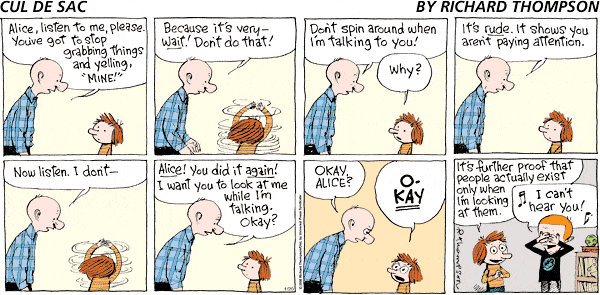 SPURGEON: I love the characterization of the kid characters. I know that you're a fan of Lynda Barry, who presents similarly damaged and off-beat but still very alive and funny children in her work. Can you describe your basic approach to writing kids? Is there any sense you have of not wanting to approach these characters in typical kids-strip fashion?
SPURGEON: I love the characterization of the kid characters. I know that you're a fan of Lynda Barry, who presents similarly damaged and off-beat but still very alive and funny children in her work. Can you describe your basic approach to writing kids? Is there any sense you have of not wanting to approach these characters in typical kids-strip fashion?
THOMPSON: Lynda Barry, jeez, I've got about ten wonderful years of
Ernie Pook stuck in my head. I don't know, most of the way I write is instinctual, I just keep trying for the character to sound like him or herself and still say something unexpected. When I started
CdS I figured out the kids almost immediately, at least their basic characteristics. For example, Alice is the little kid who stares at you, like over the back of a booth in a restaurant, until you are kind of unnerved. She's indomitable and self-absorbed, as many a four-year-old can be, and Petey's a fish who's always out of the water. Once you know the character you hear his or her voice pretty clearly, and you're not so much writing as being dictated to. Most of the strip cartoonists I've talked to will nod their heads in recognition if you mention "hearing voices."
But yeah, I didn't want the strip to be about the zany antics of those little dickens, Alice and Petey. I wanted it to be about the kinda gently surreal parts of childhood, where the kids don't know what's going on or how things work, and maybe the adults don't either. The mom and dad are good parents but not great parents; the mom is loud and probably embarrasses her kids and the dad is awkward and embarrasses his kids for sure.
 SPURGEON: One of the things I like most about
SPURGEON: One of the things I like most about Cul De Sac
is each character inhabits their own world and
is an active participant in all of the other people's worlds; in fact, some of the humor seems to me to come from less of a culture clash than this kind of all-encompassing world view clash. Do you feel that everyone, and kids in particular, operate within their own landscapes and points of view to the degree it seems is represented by your work?
THOMPSON: Yeah, I do think that pretty much. And it's just comedy gold, you know, the confusion that results from all these little colliding worlds. Especially with kids. Listen to kids talking sometime; the responses to "I have a dog" isn't "what kind?", it's usually "I have a dog!", "I have a cat!", "I have two hamsters!", "My grandma's dog has three legs!", each getting further away from the original comment, and it spirals off into unknown territory. Also, approaching characters like each is an actor on a separate stage maybe gives them a greater chance to show some depth. That was something I noticed in
Pogo; you remember the hound dog, Beauregard Bugleboy? He was always narrating himself, "Thus the noble dog saves the day yet again, though his brow be not bedecked by a hero's wreath," that kind of thing, and it was always completely at odds with whatever was really going on. I think it'd be fun to do a strip where each character is an unreliable narrator.
 SPURGEON: You once said in an interview that the difference between your neighborhood right now with its kids and the same neighborhood when someone else lived thee with kids 30 years ago is a difference in housing prices. When you're writing the strip, how much of it do you think comes down to traditional, universal ways kids and parents have been and will continue to be over the years? Are there any things in
SPURGEON: You once said in an interview that the difference between your neighborhood right now with its kids and the same neighborhood when someone else lived thee with kids 30 years ago is a difference in housing prices. When you're writing the strip, how much of it do you think comes down to traditional, universal ways kids and parents have been and will continue to be over the years? Are there any things in Cul De Sac
that you may feel specific to now, that might not have popped up if the strip were done 20 yeas ago?
THOMPSON: Not too much, other than minor technology things like cell phones and such. Alice & Petey are four and eight, and those ages aren't as intensively technologically obsessed as, say, an adolescent who's nuts for wii. I can keep them at least a little innocent of the cutting edge stuff. And as to cultural and societal stuff, I'm writing this from the point of view of a somewhat alert if self-absorbed four-year-old, so I can deal with things or ignore them, and a four-year-old is likely as not going to ignore them.
Bill Watterson said something to the effect that writing
Calvin was writing for a lazy six-year-old and how hard is that?
I'm not sure what point I was trying to make with the neighborhood comparison, but here's one definite thing I noticed when I was trying to put
CdS together. I was walking down the street with one of my daughters when she was maybe five, and just kinda watching her admire certain things; a nice rock, a telephone pole with a lost cat notice on it, some interesting dirt that had washed up in front of a storm drain. And it struck me how differently a kid sees the neighborhood than an adult. There's a manhole cover that's set in the sidewalk, in an elevated slab, a few blocks from my house, and when the girls were smaller they'd have to stop and dance around on it, put on a little 20 second show, every time we walked by. Then they'd take a bow and we'd keep on going. A couple of years ago I saw a parent with a small child walk by it and stop while the kid performed the same little ritual, the manhole cover dance routine. To an adult the thing was barely even there, just a lump of cement, but to a kid it was a stage for performing. That's the kind of stuff I want put in
CdS, some little kid dancing around on a manhole cover for no good reason with the parent standing there teetering between patience and aggravation.
*****
* impressive
Cul De Sac promotional illustration
* self-portrait
* drawing of pig swiped from Thompson's blog
* a Thompson caricature
* Gene Weingarten, as drawn by Thompson
* "Make The Pie Higher"
* a portion of one of the restaurant closing strips mentioned
* illustration work
* Mr. Dander, from
Cul De Sac
* various art or full strips from
Cul De Sac
* Alice and Petey (below)
*****
Cul De Sac
*****
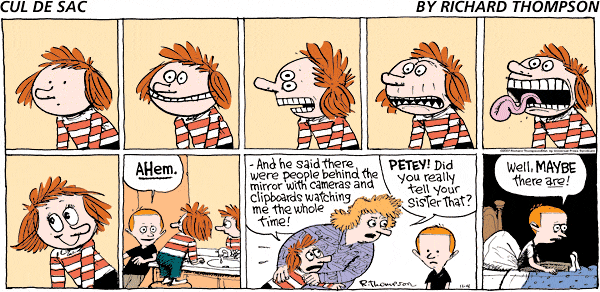
*****
*****
posted 9:00 pm PST |
Permalink
Daily Blog Archives
November 2019
October 2019
September 2019
August 2019
July 2019
Full Archives


